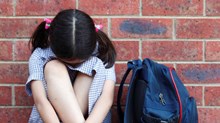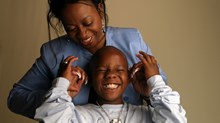Confessions of a Middle-School Bully
I remember rage—anger so intense I could pound a sibling with my fists; threaten the mean, biting dog next door; or tackle a neighborhood boy in the front yard. At four years old, the targets of my rage were usually bigger than me, so mustering enough force to inflict serious pain was unlikely. I could, however, kick hard enough to bruise a few shins and was often fast enough to catch an antagonist before he or she escaped at a full run.
At four, I wore hard, red leather shoes. My brothers, sisters, and the neighborhood kids feared them. My hard, red shoes were my go-to weapon and enforcer when I felt threatened or picked on. I remember angrily running to my closet, forcing the shoes onto my bare feet, and running for the front door with the laces untied. The boys who provoked me yelled before they scattered: "She's got her shoes on!"
Rage Begins
Except for those moments of angry chasing through the yard, I hated wearing shoes. I'd pull off my shoes and socks in winter or summer, walking in the snow, or rain, or baking hot sun. My feet were tough, like me, so it didn't matter where I ran or played—the farmer's field with its head-tall grass, the wooded easement behind the houses, or the concrete sidewalk that took my brothers and sisters to school.
My family lived on a dead-end street. The house between our home and the farmer's field was an asbestos-sided ranch that leaned from overgrowth. A junkyard house with cars collapsed on flattened tires and galvanized-gray garbage cans dented and scattered by the back concrete steps. A six-foot fence blocked the sun on two sides, keeping the vision of light-filled grass and red-sided barn from reaching my backdoor. Tall oaks canopied, pressing darkness to the ground.
This dilapidated house was the abrupt end of my childhood innocence. A family of pedophiles—a father and two sons. It was the beginning of—and the reason for—my rage.
At the age of four, fear occupied my days and nights. I had night terrors, reliving the untold secrets of the junkyard house. I had day terrors, freezing up between the biting dog and the dark woods. Fear gripped me until I experienced rage. Rage was better and less terrifying.
In 2012, the U.S. Department of Health and Human Services reported 686,000 cases of child maltreatment. More than 9 percent of these victims were the result of sexual abuse and one-third were younger than nine years old. As a contributing factor to bullying behaviors, child abuse is only one metric within the complex interactions between the child, family, peer group, school environment, and society. In my experience, the unresolved implications of early childhood sexual abuse were the incubator that would eventually turn me into a middle-school bully.
Depression and Victimization
When I was six years old, we moved. I grew up in a nice suburban neighborhood with a stay-at-home mother who baked bread and apple pie. She took me to church and I memorized the books of the Bible. My dad was good. I practiced the piano and played the violin. The darkness of the junkyard house was my secret and I never shared it, but I was drawn to children with dark and painful histories. The friends I chose were the children of alcoholics, addicts, and the physically abusive. It was as though we recognized and embraced our differentness without knowing or understanding why we were corrupt.
In elementary school, boys taunted and harassed me in front of other children and school faculty. I was threatened with social aggression, ridiculed, and publicly humiliated. While teachers acknowledged the playground bullying behaviors, there was no attempt to intervene. By age 12, I considered running away from home and suicide as viable and less painful options than attending school.
In my case, my own inner pain would begin to directly impact the way I treated others—and this is often the case with bullying. According to the Center of Disease Control (CDC), both victims and perpetrators of bullying behaviors may feel isolated, depressed, or have low self-esteem. Bullying is a complex social problem, which includes victims, bullies, and bystanders. The highest risk category, according to studies cited by Bullying Prevention and Intervention: Realistic Strategies for Schools, are called bully-victims. Bully-victims are the segment of children who report being both victims of bullying and perpetrators of bullying behaviors. These victim-perpetrators display the highest levels of depression and the lowest levels of student engagement.
Middle School: The Peak of Bullying Behaviors
My aggression toward other students began as I transitioned from elementary to middle school. For me, it was an escape from weakness—a fleeting sense of control in a torrent of self-destructive emotions. My friends and I protected each other from threats, both real and perceived. We sought connection and escape from not only the elementary-school bullies, but from dark histories, raging fathers, and drunken parents.
Together we staked our claim on territories in and around the school, occupying bathrooms, hallways, lunch tables, doorways, and sidewalks. We guarded these spaces through teasing, physical threats, and pushing. Our delinquent behavior intimidated boys and girls at sporting events, roller rinks, and school dances where smoking and drinking became our hallmarks.
When alone, I was fearful and insecure, desperately wishing I could participate in the friendships and inclusive relationships that belonged to other girls. I deeply regretted my hostile behavior and often tried to befriend girls brave enough to speak with me in private. These friendships disintegrated not from lack of trying but from my inability to feel a sense of belonging. Girls who did not self-deprecate or feel inward hostility were a stark contrast to my own depleted self-image. In the end, I was unable to defend these relationships from my own self-loathing and my hostile and jealous tribe.
Children with unpleasant histories often rage and bully. Sometimes friends are aggressive toward each other (relational aggression), but more frequently they rage against victims with similar presenting behaviors, such as low self-esteem and depression. Anger is a "significant predictor of bullying perpetration," according to Bullying Prevention and Intervention. Some studies show that children with low self-esteem and depression may initiate bullying behaviors as a way to feel better.
As a childhood bully-victim, I understand that victimization is multifaceted. The behaviors that made me an easy target for abuse in elementary school also made me an easy target for the peer pressure and the gang mentality that contributed to my bullying behaviors.
While not all victims of child sexual abuse present long-term behavioral consequences (such as bullying victimization or perpetration), the behavioral patterns of abuse and those that lead to bullying are similar, including increased fearfulness, anxiety, frustration, acting out, and anger. In adolescents, presenting behaviors also include substance abuse and delinquency. Each of these behaviors is associated with the factors that contribute to bullying.
A Solvable Problem
Today, 49 states have passed anti-bullying laws and thousands of schools have implemented anti-bullying policies. Within these policies, there are prescribed actions not only for the care of victims but also for the development of supportive environments that reward positive peer relationships.
It's difficult to speculate about an alternate ending to my own story and the circumstances that led to my bullying behaviors. I was already well on my way to self-destruction when I was bullied in sixth grade. Those years of social ostracism certainly played a significant role in my aggressive acting out in middle school. At times I wonder: If a parent, teacher, administrator, or counselor had intervened, would I have been able to speak up and get help? Could things have been different for me?
Both victims and bullies need strong, supportive communities that are unafraid to approach these behaviors as solvable social problems. Through education, prevention, and intervention, children can be freed from the destructive emotions and behaviors that cultivate fear on our playgrounds and bring light to the dark secrets that make demons of our youth.
Mary Goodrich serves as marketing director for Today's Christian Woman, SmallGroups.com, Christian Bible Studies, and Men of Integrity. Follow Mary on Twitter at @marysramblings.
Read more articles that highlight writing by Christian women at ChristianityToday.com/Women
 Read These Next
Read These Next



 We Never Loved Each OtherWe never even really liked each other. How would our marriage last?
We Never Loved Each OtherWe never even really liked each other. How would our marriage last?
 Raising Strong Christian Boys5 ways I’m building up my sons’ character
Raising Strong Christian Boys5 ways I’m building up my sons’ character








 Homepage
Homepage